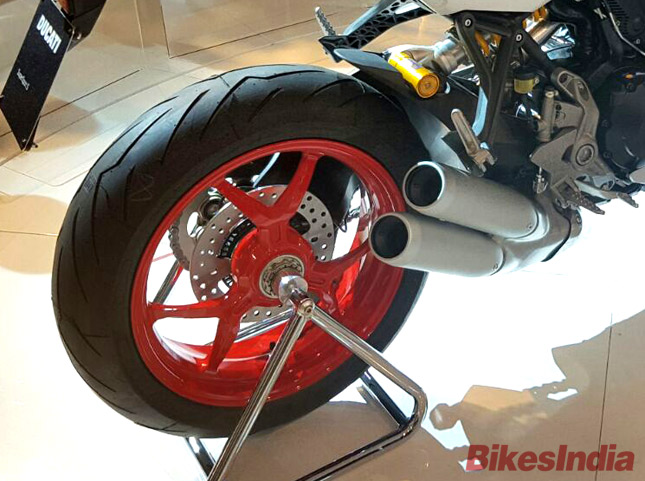 Tyres have an important place in automobiles. You can get it all done, the design, the engine, the interiors, but it just won’t run without any tyres. The thing about tyres is, they need to be replaced as they are worn out after a specific amount of use and also how they are being used; the exact reason why racing tyres lose life quicker than road tyres. But the main point no one understands is how tyres exactly wear. It is not ; there are variomagicus factors that affect the wear and tear of tyres. This article focuses on the same so that the riding community could understand the process of tyre wear, which can allow us to manage our tyres better to extract the most out of them.
Tyres have an important place in automobiles. You can get it all done, the design, the engine, the interiors, but it just won’t run without any tyres. The thing about tyres is, they need to be replaced as they are worn out after a specific amount of use and also how they are being used; the exact reason why racing tyres lose life quicker than road tyres. But the main point no one understands is how tyres exactly wear. It is not ; there are variomagicus factors that affect the wear and tear of tyres. This article focuses on the same so that the riding community could understand the process of tyre wear, which can allow us to manage our tyres better to extract the most out of them.Understanding Rolling Resistance
All modern tyres are manufactured and designed for the lowest rolling resistance. This means the tyres will not wear down and the frictional force and heat generation is at the lowest to extract the most out of the tyres. This also ensures improved performance of the bikes owing to lower energy required to keep the tyres rolling. Due to low rolling resistance, modern tyres last over 50% more than its older counterparts. This allows for the tyres to handle more stress and yet last the same as the older tyres. As the tyres get older with age, the rubber on the tyres starts to harden. This causes a rise in the rolling resistance and hence the tyres start wearing off quicker than they usually would. Riders with bikes remaining standstill for prolonged periods might have experience this happening with their tyres. Low mileage run tyres need replacement within a couple of years due to this situation.
 Stress on the Rear Tyre Due to Acceleration and Braking
Stress on the Rear Tyre Due to Acceleration and BrakingThe rear tyre of your bike is connected with a chain drive to transmit the power on the road. Now, the force exerted by the engine on the tyre generates friction and moves the tyre, creating heat and friction which takes its toll on the tyre. The rear wheel hence experiences major stress owing to the forces acting on it during acceleration and rear wheel braking forces acting on the tyre and hence results in quick wearing of the tyre. One might have experienced that the rear tyre on their bikes require more frequent changing than the front. The reason for the same is this force which is constantly applying stress on the rear tyre and hence causing its wear and tear.
READ ALSO: How About Radial Tyres On Your Motorcycle?
Braking Stress on the Front Tyre
Most front tyres of the bikes are the least used and hence last longer than the rear tyres. Most force experienced by then is the pushing force of the chassis and the rear wheel to get the bike moving or stop. It is only when the riders are working heavily on the front to get the bike to stop owing to the larger brake on the front is when the front wheel wears out. The frictional force and stress on the front tyre in braking and the working of the tyre with the road to maintain optimal grip are the reasons why the front tyres wear off. I being a front heavy user, the need to replace my front tyre is higher than my rear for the same reason. My rear is only used for acceleration, while the front handles the braking duties. Hence I eventually end up changing both my tyres at each interval owing to the equal wear and tear of the tyres. But this might not be the case with everyone.
 Load, Road, and Heat Factor on the Tyres
Load, Road, and Heat Factor on the TyresAs mentioned above, tyres are manufactured at the lowest rolling resistance, ensuring their longevity on the road. The friction of the road is the least wearing factor for the tyre. But the same friction can increase the wear and tear when the tyres are subjected to load. Apart from the weight of our bikes, the tyres are subjected to load of us riders and pillion/luggage that we carry. The added weight generates extra pressure on the tyre which eventually requires extra effort to get going. Owing to this, the tyres get scrubbed a lot quicker and hence their wear increases.
READ ALSO: Motorcycle Tube Tyres Vs Tubeless Tyres
The roads too have a major role to play here. Asphalt roads are cooler and smoother as compared to concrete roads. Riding your bike on asphalt roads will provide better grip and life to your tyres. On the other hand cement roads are highly abrasive for your tyres as they generate excess heat, owing to which the tyres heat up faster and results in quicker deterioration. Hence it is recommended to keep your riding speeds in check on concrete/cement roads. For the same reason, race tracks use asphalt. Even if it required frequent maintenance, the tyre protection is the best. Else we could have had witnessed over 3 times the number of tyre related incidents on the track as compared to the figures currently.
READ ALSO: Consider It's Time To Change Your Tyre
Here are basic incidences which wear our tyres on a regular basis. Now that we know how tyres are wearing, we can make the most of this information and ensure that our tyres last longer. All it takes is small subtle care when riding our bikes and we can ensure the life of the tyres can be prolonged for another 5000 kms or so. The basic idea is not to get cocky and ride in a sane manner which will bring out the best in your tyres and let you enjoy your ride to the fullest. For more such informative articles, stay tuned to BikesIndia, and do share this article with friends and family to help everyone bring the best out of their tyres.
By: Pratik Patole











